Blue is a rare color for animals in the wild — in fact, it is one of the least common colors seen in the natural world. When blue does show up in nature, however, it always does so in a striking and beautiful way. Many snakes around the world display brilliant shades of blue, from the brilliant Blue Racer Snake to the decorative patterns of the Blue-Striped Garter Snake. Take a look at the beauty of these 13 blue snakes.
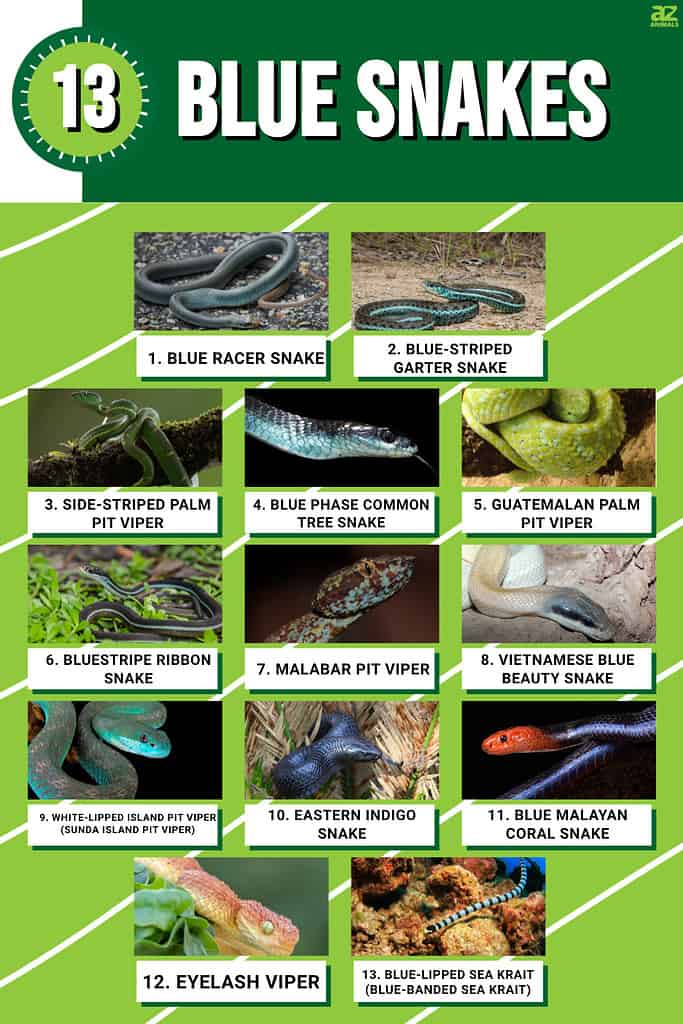
13. Blue-Lipped Sea Krait (Blue-Banded Sea Krait)
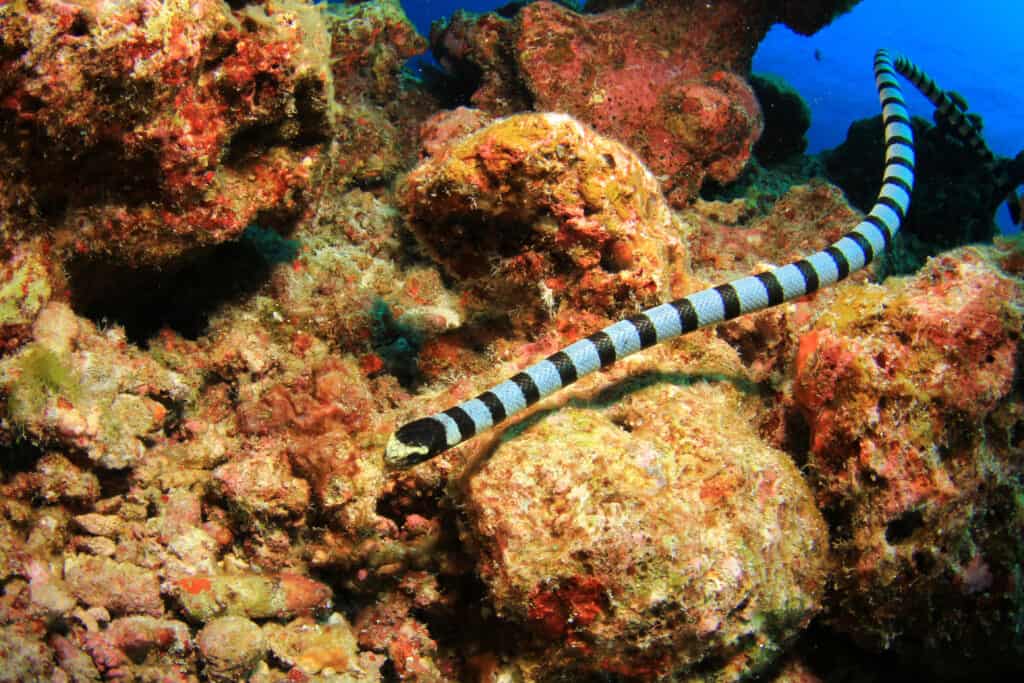
Blue-Lipped Sea Kraits have tiny fangs so their bites are not painful, even though they are deadly.
©Rich Carey/Shutterstock.com
The Blue-Lipped or Blue-Banded Sea Krait is an extremely venomous species of sea snake that lives in the western Pacific Ocean and Indian Ocean. This snake can grow between 36-42 inches in length, with uniform black banding along the length of its smooth blue body. The blue-lipped sea krait is semi-aquatic, alternating between time spent on land and hunting in ocean waters. This snake often hunts along coral reefs and has a highly potent neurotoxic venom. However, it is non-aggressive and quite docile and typically avoids humans.
12. Eyelash Viper

The Eyelash Viper comes in variations of orange, blue, red, gray, black, yellow, brown, and olive.
©iStock.com/Mark Kostich
The Eyelash Viper gets its name from the scales jutting out above its eyes, making it look like it has delicate eyelashes. This snake has many different color morphs, ranging from blue to green, brown, yellow, red, and pink.
Some eyelash vipers may even have a combination of multiple colors, and some will also have dark speckling along their bodies as well. Eyelash vipers are arboreal and live in tropical forest trees in Central and South America. These are venomous and aggressive snakes that will strike when threatened or harassed.
11. Blue Malayan Coral Snake
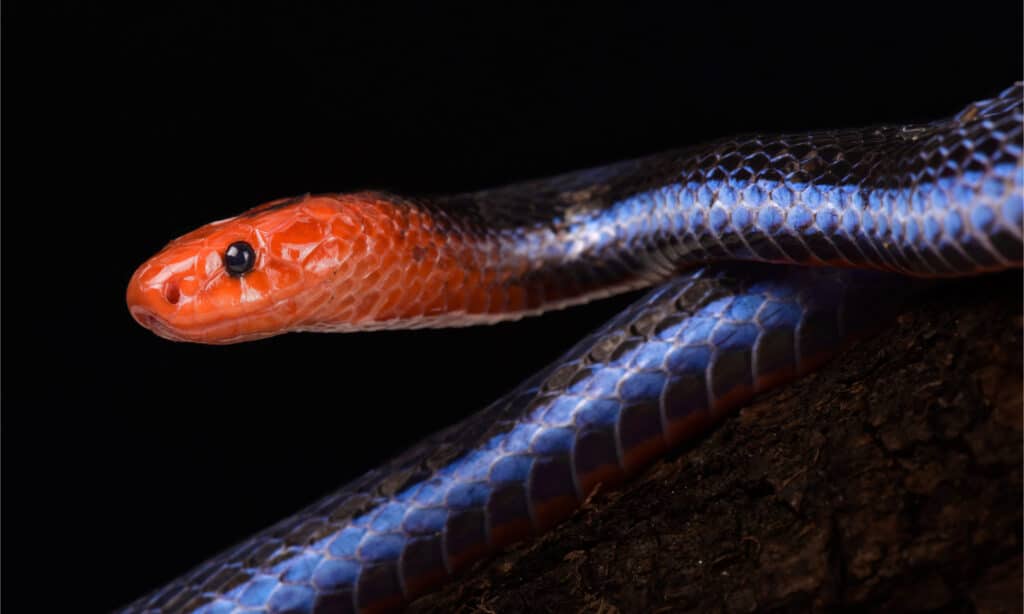
The Blue Malayan Coral Snake is beautiful but deadly.
©reptiles4all/Shutterstock.com
The Blue Malayan Coral Snake has a thin, dark blue or blue-black body that starkly contrasts with the vibrant red of its head, belly, and tail. A white or light-blue stripe runs along the length of each side of its body as well. These striking, colorful snakes live in Southeast Asia, growing 55-70 inches in length. Blue Malayan Coral Snakes have very toxic venom that can cause immediate paralysis.
10. Eastern Indigo Snake
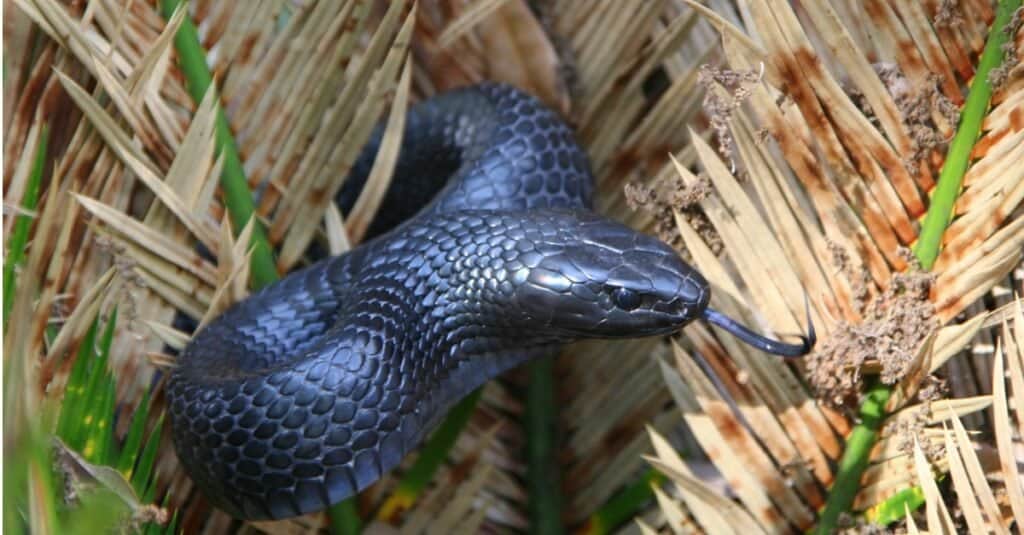
The Eastern Indigo Snake’s head and body are about the same size and it doesn’t have much of a neck.
©iStock.com/sstaton
The Eastern Indigo Snake is a large, nonvenomous snake found in the southwestern United States. This snake has a deep blue-black body with smooth, polished scales that shine iridescently in the sun. Some snakes will also have shades of red, orange, or tan on the chin, cheek, and throat.
Eastern indigo snakes are very large, growing 5-7 feet long and weighing 2-10 pounds. However, the longest Eastern indigo snake recorded was over 9 feet long! Despite their large size, these snakes are extremely gentle and docile. The Eastern indigo snake is a federally threatened species. There are many ongoing efforts to reestablish the diminished populations of this charming snake.
9. White-Lipped Island Pit Viper (Sunda Island Pit Viper)
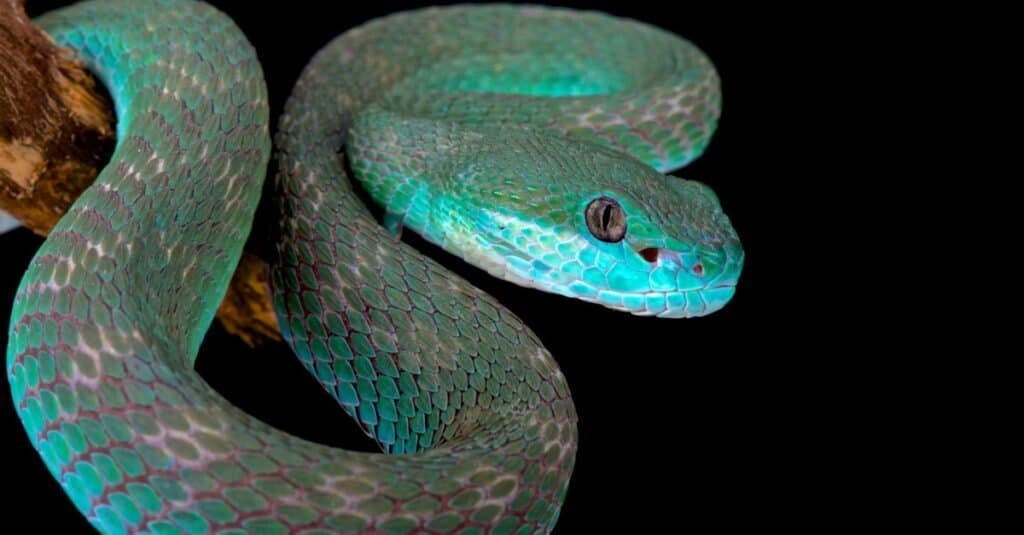
The blue White-lipped Island Pit Viper is endemic to Komodo Island and surrounding islands.
©iStock.com/reptiles4all
The White-Lipped Island Pit Viper, or Sunda Island Pit Viper, is a venomous snake found on the Lesser Sunda Islands and in Eastern Java. These island-dwelling snakes have brilliant green, blue-green, or yellow bodies depending on where they live.
Blue snakes, however, are quite rare and are primarily found on Komodo Island. White-lipped Island pit vipers are arboreal snakes that live in trees. These snakes are very aggressive and have toxic venom, although it is not typically fatal to humans.
8. Vietnamese Blue Beauty Snake
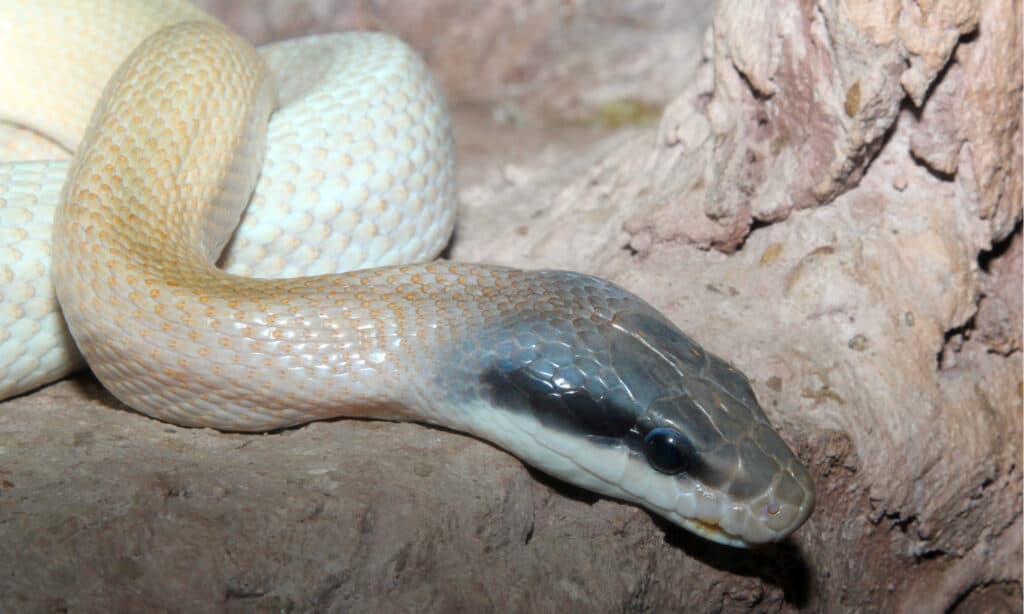
The Vietnamese Blue Beauty rat snake is a subspecies of the Beauty rat snake, like the cave-dwelling rat snake pictured above.
©Michal Sloviak/Shutterstock.com
The Vietnamese Blue Beauty Snake certainly lives up to its name. This beautiful snake grows between 5-11 feet in length, with a slender blue or silver body. The head and neck are solid in color, with a thick dark stripe from each eye to the back of its mouth.
The rest of the snake’s body is covered with dark uniform geometric patterns. Near the tail these dark markings get closer together, fusing into uniform squares and rectangles. Its tail is often solid in color, with thin light-colored stripes. The Vietnamese Blue Beauty Snake is a subspecies of the Beauty Rat Snake that lives in tropical rainforests in Vietnam, Cambodia, and Thailand.
They are the most popular subspecies of Beauty Rat Snake to keep as pets. As far as personality goes, however, some have docile temperaments, while others can be aggressive. Even a friendlier beauty snake can get aggressive if it feels threatened, and its bite is painful, though non-venomous.
7. Malabar Pit Viper

Malabar Pit Vipers are ambush predators that can strike quickly.
©ananth-tp/Shutterstock.com
The Malabar Pit Viper is a venomous snake that lives in southwestern India in the Western Ghats or Sahyadri Mountain Range. These snakes come in many different colors, like brown, yellow, green, and light blue. Some snakes will also have brown and black jagged blotches or zigzag patterns along their backs, while others have faded markings or no markings at all.
These beautiful snakes are most common during the monsoon season. While they typically move slowly, Malabar Pit Vipers are quick to strike. Their bites, however, are not fatal to humans, although they will cause pain and swelling for a few days.
6. Bluestripe Ribbon Snake
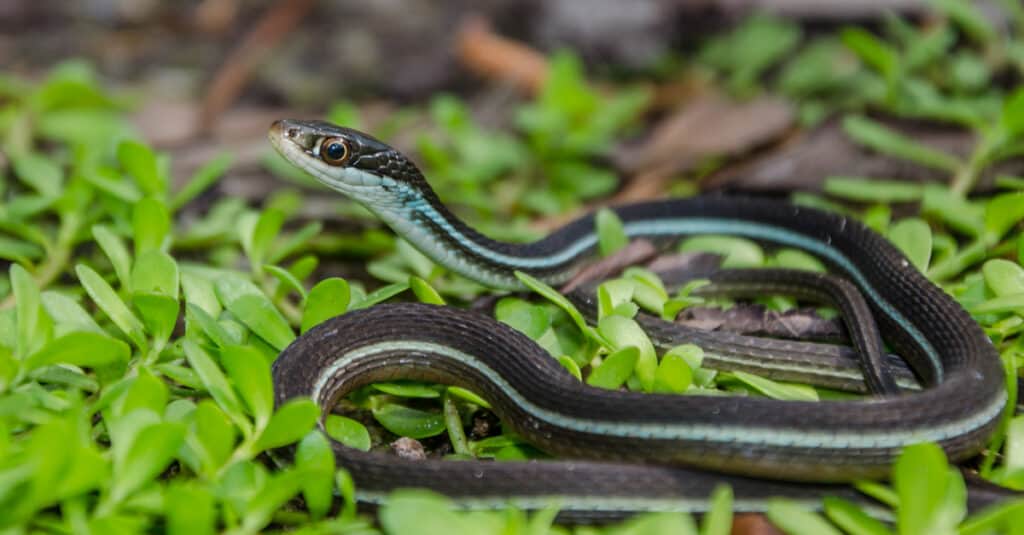
The Bluestripe Ribbon Snake has a long, slender body that resembles a ribbon.
©Jay Ondreicka/Shutterstock.com
The Bluestripe Ribbon Snake is a subspecies of Ribbon Snake that lives in Florida, along the Gulf Coast. These snakes are 18-25 inches long with thin, narrow bodies like a ribbon. Bluestripe ribbon snakes are black, blue-black, olive-black, or brown with a light blue or tan-colored stripe running along each side of their bodies. These snakes are nonvenomous, semi-aquatic snakes that eat frogs, salamanders, earthworms, and small fish.
5. Guatemalan Palm Pit Viper
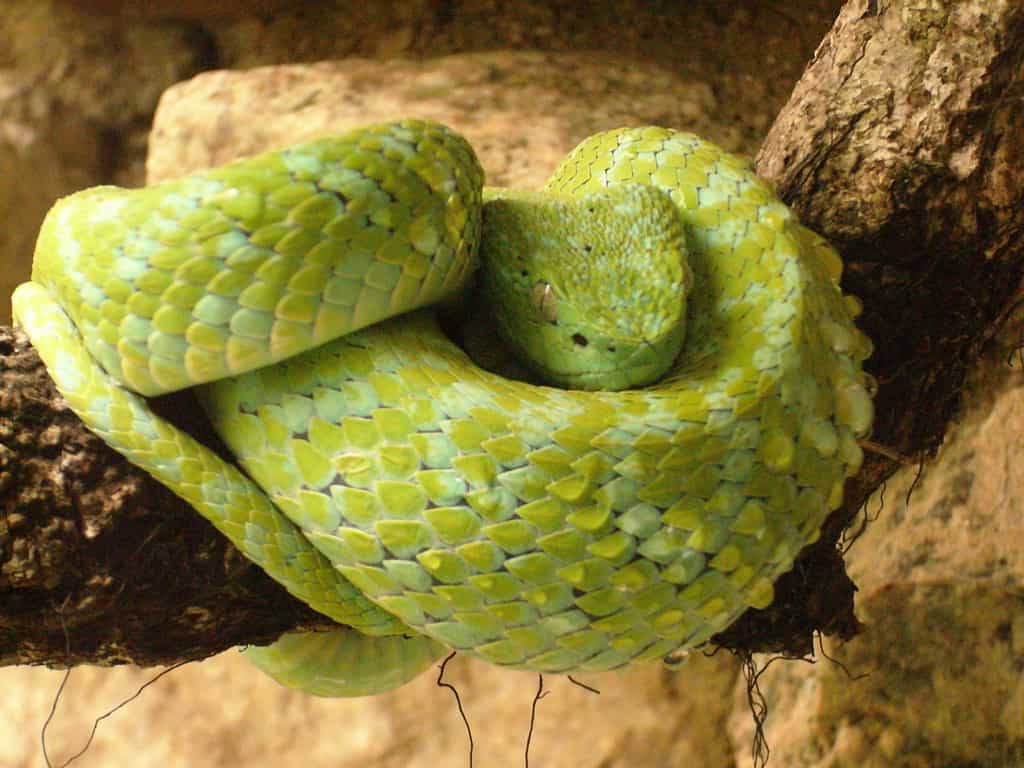
These pit vipers often have blue skin between their scales, and some scales may have blue borders as well.
©Juan Paulo Carbajal-Borges, CC BY-SA 2.0 – Original / License
The Guatemalan Palm Pit Viper is a venomous snake that lives in the forests of Guatemala, Honduras, and southern Mexico. These snakes are green or blue-green in color and typically grow 24-28 inches in length. They often have blue skin between their scales, and some scales may have blue borders as well. The snakes in Mexico have additional black or blue markings in the form of patches, dots, or flecks along their bodies.
4. Blue Phase Common Tree Snake
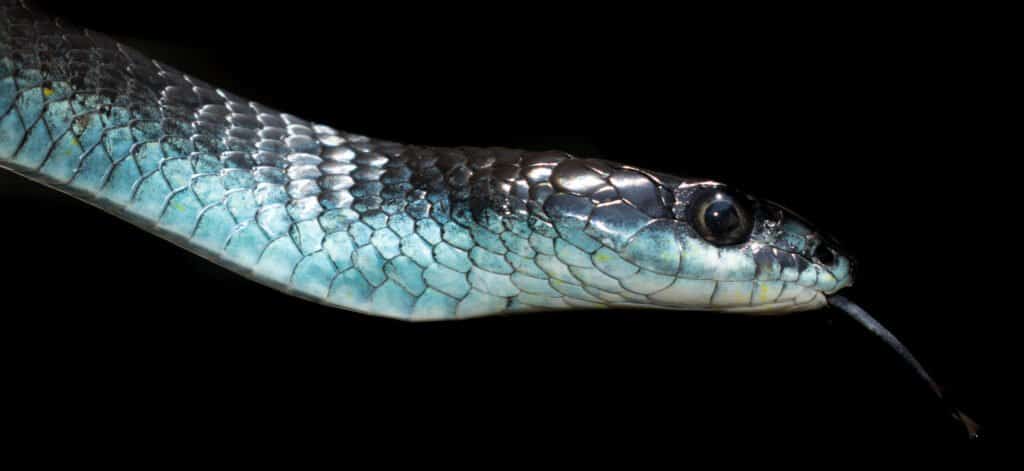
The Blue Phase Common Tree Snake’s unique blue color is caused by a genetic variation.
©Jake Goldring/Shutterstock.com
The Blue Phase Common Tree Snake is typically yellow, green, brown, or black. On rare occasions, however, these snakes are completely and beautifully blue! The entire body of a blue-phase common tree snake is blue, although the shade and vibrancy are different for each snake. Some are neon or bright blue, while others are dull or navy blue.
Common tree snakes are completely harmless, nonvenomous snakes that can grow up to six and a half feet long. These snakes live in Australia and primarily eat skinks and frogs.
3. Side-Striped Palm Pit Viper

Side-Striped Palm Pit Vipers in captivity have been reported to turn bluer as they age.
©Vaclav Sebek/Shutterstock.com
The Side-Striped Palm Pit Viper is an emerald-green or blue-green snake with a very thin yellow stripe running down either side of its slender body. Some snakes also have blue or black-tipped scales along their yellow stripes. Occasionally they may have a blue stripe behind their eyes as well.
The side-striped palm pit viper is a venomous snake that is typically found in the lower mountain forests of western Panama and Costa Rica, as well as caves in Vietnam, Cambodia, and Thailand. It is a cathemeral snake, which means that it is active at seemingly random times throughout the day as well as at night.
2. Blue-Striped Garter Snake

The blue-striped garter snake is found in Florida and can come in a few colors. Most notably, they can come in a striking shade of blue.
©Jay Ondreicka/Shutterstock.com
The Blue-Striped Garter Snake is a subspecies of garter snake that lives in Florida. Its slender body is gray, tan, greenish-brown, or black, with a yellow, white, brown, green, or blue stripe running down each side of its body. It also has another matching stripe running down the middle of its back as well.
Blue-striped garter snakes are 18-26 inches long with slender bodies and large eyes. These snakes swallow their food whole while it is still alive. They eat salamanders, earthworms, freshwater fish, snails, slugs, leeches, and small mammals.
1. Blue Racer Snake

Blue Racer Snakes come in many different shades of blue, from light or dark tones to bright or dull hues.
©Teresa Considine/Shutterstock.com
The Blue Racer Snake is a subspecies of the Eastern Racer with a long, elegant body measuring 36-60 inches in length. These snakes can sport various shades of blue, from brilliant sapphire blue to grey-blue and deeper midnight blue. They have dark markings around their large eyes and along the sides of their faces. Their chins and necks are often white or cream that bleeds into a lighter shade of blue.
Blue racer snakes live in areas of the northwestern United States and have been observed in Ontario, Canada, where they are listed as a threatened species. These snakes prefer dryer habitats that have plenty of cover as well as spots for sunning. They are often found in fields, open forests, pastures, and around marshes.
Like their name, blue racer snakes are quite fast and can be nervous. When they feel threatened, to mimic a rattlesnake and shake their tails. Blue racer snakes hunt during the day, eating grasshoppers, beetles, crickets, frogs, rodents, and other snakes.
What Animals Are the Color Blue?
There are relatively few naturally occurring blue animals in the world. Some examples include:
- Blue jays: A bird species native to North America, known for its distinctive blue plumage and crest.
- Blue morpho butterflies: A species of butterfly found in the rainforests of Central and South America, known for its bright blue iridescent wings.
- Blue whales: The largest animal on earth, known for its bluish-gray skin and enormous size.
- Blue-ringed octopuses: A small species of octopus found in the Pacific and Indian Oceans, known for its bright blue rings and highly venomous bite.
- Blue crabs: A species of crab found in the Atlantic Ocean, known for its blue-tinted claws and ability to swim backward.
There are a few other species of animals that have blue coloration, but these are some of the most well-known examples. It’s worth noting that many animals have blue pigments, but these pigments are often hidden under other layers of skin or feathers and are not visible to the naked eye.
Summary of 13 Blue Snakes
Celebrating the beauty of blue reptiles, here’s a recap of 13 captivating blue snakes:
| Rank | Snake | Location |
|---|---|---|
| 1 | Blue Racer Snake | Northwestern United States/Ontario, Canada |
| 2 | Blue-Striped Garter Snake | Florida |
| 3 | Side-Striped Palm Pit Viper | Panama/Costa Rica/Vietnam/Cambodia/Thailand |
| 4 | Blue Phase Common Tree Snake | Australia |
| 5 | Guatemalan Palm Pit Viper | Guatemala/Honduras/Mexico |
| 6 | Bluestripe Ribbon Snake | Florida |
| 7 | Malabar Pit Viper | Southwestern India |
| 8 | Vietnamese Blue Beauty Snake | Vietnam/Cambodia/Thailand |
| 9 | White-Lipped Island Pit Viper(Sunda Island Pit Viper) | Sunda Islands/Western Java |
| 10 | Eastern Indigo Snake | Southwestern United States |
| 11 | Blue Malayan Coral Snake | Southeast Asia |
| 12 | Eyelash Viper | Central & South America |
| 13 | Blue-Lipped Sea Krait (Blue-Banded Sea Krait) | Western Pacific & Indian Ocean |
The photo featured at the top of this post is © Kurit afshen/Shutterstock.com
Discover the "Monster" Snake 5X Bigger than an Anaconda
Every day A-Z Animals sends out some of the most incredible facts in the world from our free newsletter. Want to discover the 10 most beautiful snakes in the world, a "snake island" where you're never more than 3 feet from danger, or a "monster" snake 5X larger than an anaconda? Then sign up right now and you'll start receiving our daily newsletter absolutely free.
Thank you for reading! Have some feedback for us? Contact the AZ Animals editorial team.







